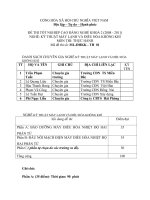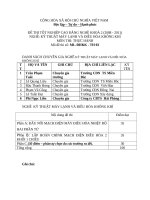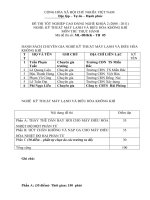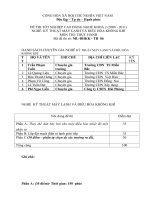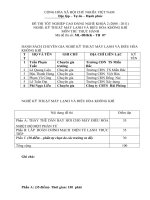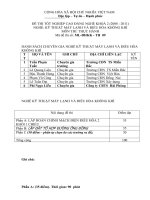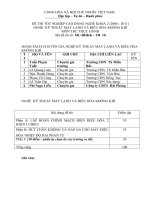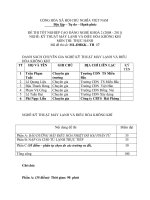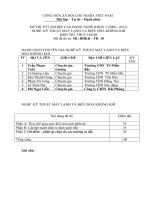- Trang chủ >>
- Đề thi >>
- Đề thi lớp 12
Đề thi thực hành olympic hóa học nga 2017 Russian Mendeleev Olympiad
Bạn đang xem bản rút gọn của tài liệu. Xem và tải ngay bản đầy đủ của tài liệu tại đây (204.73 KB, 9 trang )
51st INTERNATIONAL MENDELEEV CHEMISTRY OLYMPIAD
April 24-29, 2017
Astana
PRACTICAL EXAM
ASTANA 2017
General directions
1.
You will have 15 min to read the text and plan your work before the exam. You are not allowed writing
anything or starting the experiment with in this time.
2.
Wearing your lab coat and goggles (or you own correcting) is obligatory during the whole experimental
exam.
3.
Take care when handling the acid and alkali solutions!
4.
Fill pipettes using pipette filler only. It is absolutely prohibited to suck solutions into the pipette.
5.
The amount of the provided solutions is limited. A spilled or completely used up solution will be
replaced with penalty.
6.
You are provided with clean dry pipettes and a burette. Do not spend the solutions for rinsing them.
7.
Pour used solutions into nearest sink (larger or smaller).
8.
When working do not interfere with other Olympiad participants. Keep your working place in order.
9.
If you have broken anything, ask your lab assistant. He/she will help you disposing the glassware and
provide you with the substitute.
10.
Use the back side of the booklet sheets for your draft work.
11.
Total duration of the exam if 5 hours (including the time allocated for reading). After the STOP
command you should immediately stop you work and hand over the Answer Sheets and the synthesis product
to your lab assistant.
2
Chemicals and glassware
Name
Quantity
For each participant
Lebeled
Potassium iodide, 120 g/L
Hydrochloric acid, 1M.
22 mL
20 mL
KI 12% (m/v)
HCl 1M
Ethanol 96%
Phthalic anhydride, solid
C2H5OH
Phthalazole (a drug sample) in the 50 mL beaker
40 mL
0.625 g
The weighed
sample
Sodium hydrogen carbonate, solid, weighed sample of 2 g
100 mL beaker (for TLC)
4 pcs.
1 pc
NaHCO3
TLC camera
Plastic watch glass
25 mL volumetric flask with a stopper
150 mL conical flask for titration with a weighed sample of
sulfathiazole (1.25 g)
250 mL beaker with the thiosulfate solution
250 mL conical flask (for filtrate)
2 pcs
1
Vial for the product dissolution (for TLC)
10 mL measuring cylinder
1 pc.
50 мл
1 pc.
1 pc.
Phthalic anhydride
-
Na2S2O3 0.1000 M
For filtrate
1 pc.
1 pc.
10 mL graduated pipette
5 mL graduated pipette
1 pc.
1 mL graduated pipette
1 pc.
1 pc.
Burette
Funnel for filtration
Small funnel for the burette
Glass rod
Wash bottle with distilled water
TLC plate with UV indicator
TLC capillary
Paper filter
Pipette filler (bulb)
Lab stand with a burette clamp and a ring
Graphite pencil
1 pc.
1 pc.
1 pc.
1 pc.
1 pc.
1 pc.
1 pc.
1 pc.
1 pc.
1 pc.
Tissue gloves (to handle hot glassware)
Rubber stopper
1 pair
1 pc.
Shared by two participants
Heating plate
1 pc.
Acetic acid, 1:1 v/v
22 mL
CH3COOH 1:1 (v:v)
Sulfuric acid, 1:1 v/v
Potassium bromide, 10 g/L
12 mL
100 mL
H2SO4 1:1 (v:v)
KBr 10 g/L
Sodium nitrite, ca. 0.02 M.
Tropeolin 00 (indicator), 0.1% solution (in a dropper)
Starch, 1% solution (in a dropper)
Ruler
155 mL
20 mL
20 mL
1 pc.
NaNO2
Tropeolin
Starch
3
Shared by 10-12 students
Sodium thiosulfate, 0.1000 M.
400 mL
Eluent for TLC
1 pc.
10 mL measuring cylinder (for the eluent)
1 pc.
Tweezers
1 pc.
Marker
1 pc.
Paper tissues
1 roll
Latex gloves (choose your size)
M, S, L
UV lamp
1 pc.
Common equipment (for a lab)
Drying oven
1 pc.
Na2S2O3 0.1000 M
Eluent
Operating heating plates
·
Grey-white (Fischer):
- a plate with two regulators: adjust the desired plate temperature with the left regulator
- a plate with one regulator: press Power button, then press Heat button and adjust the desired plate temperature with the
round regulator.
· Blue (IKA):
- press the toggle switch (left), press the left regulator, adjust the desired plate temperature by rotating it.
The plate temperature should be selected by the trial so that the solution boils uniformly (for boiling ethanol, 140-150 deg
should be set; for boiling the aqueous solution, 210-230 deg should be set; the proper values differ for different plates and
depend on how many beakers are heated simultaneously).
4
51th International Mendeleev Olympiad, 2017
Practical exam
Name
Astana
Place #
Preparation and titrimetric determination of Phthalazol
Sulfanilamides, derivatives of p-aminobenzene sulfonamide (amide of sulfanilic acid), have been used as antibacterial drugs since mid-20th Century. Prontosil was the first representative of this group of substances and the
first synthetic anti-bacterial drug. Prontosil is not used nowadays, but a variety of its derivatives have been
synthesized and put to practice. In particular, Phthalazol and Sulgin are applied to cure infectious deceases of
gastrointestinal tract due to slow absorption and prolonged release in the intestine in therapeutic concentration.
In this task you will synthesize phthalazol and determine its quantity by titrimetry. You will also have to
standardize the titrant (sodium nitrite).
Part I. Preparation and identification of phthalazol
Phthalazol (Phthalylsulfathiazole, C17H13N3O5S2, М = 403 g/mol) is white or yellowish powder (melting point
264-277°C), insoluble in water, dilute acids, ether, and chloroform. It is readily dissolved in
dimethylformamide and dilute solutions of alkali, carbonates, and hydrogen carbonates, and is poorly soluble in
ethanol and acetone. Phthalazol is typically obtained via heating of 2-(p-aminobenzene-sulfonamid)thiazol
(sulfathiazole, norsulfazole) with phthalic anhydride in an alcohol or by interfusing these substances:
I.1. Synthesis of phthalazol
Add the weighed sample of phthalic anhydride (0.625 g) and 12 mL of ethanol to the weighed sample of
sulfathiazole (1.25 g, in the conical flask). Cover the mixture with the watch glass and gently boil for 5 min
avoiding too intense boiling. You will first observe dissolution of all the substances, followed by the product
precipitation. Cool down the flask under tap water and add 12 mL of distilled water. Label the filter paper
(write your student’s code with the graphite pencil). Filter off the precipitate using the paper filter. Transfer the
precipitate leftover from the flask onto the filter using several 3-5 mL portions of ethanol.
Place a few corns of the product into the 20 mL vial for further TLC analysis. Fold the filter to avoid the
product loss due to the fan in the oven. Place the folded filter onto a plastic watch glass. Ask your lab assistant
to place the filter with the product into the drying oven. The product will be weighed by your lab assistant.
Before handing your product to your lab assistant please make sure that your filter is labeled.
5
51th International Mendeleev Olympiad, 2017
Practical exam
Name
Astana
Place #
I.2. Identification of phthalazol by means of thin layer chromatography
First set the chromatography chamber. Using the cylinder, pour 2-3 mL of the eluent (ethanol – acetic acid, 9:1
v/v, placed on the table of common use) in the 100 mL beaker and cover it with the plastic watch glass to
saturate the chamber with the solvent vapor. Add about 1 mL of ethanol to the 20 mL vial containing the
product corns, and swirl the vial (the product is not completely dissolved due to the low solubility). Using the
capillary apply about 1 mL (touch the plate 1-2 times) of the obtained solution onto one of the lines marked with
the pencil (the start line). Any excess of the compound on the plate leads to the spot tailing. You are
recommended to apply two different volumes of the solution at the start line at 0.5-0.8 cm distance between
them. Dry the plate at air and put it into the chamber. (The start line should not be immersed in the eluent!) Let
the front attain the second line, then remove it from the beaker (use the tweezers, at the table of common use)
and let the eluent evaporate. Write down your student’s code with the pencil at the spare part of the plate and
observe the spot under the UV lamp (approach your lab assistant). Encircle the spot immediately with the pencil
and measure the distance from the start line to the spot center. Write down the result and calculate Rf value:
Distance from the start line to the
spot center l, cm
Rf = l / L, where L is the front line
distance
Deliver the plate with the Answer Sheets. Make sure that there is your student’s code at the plates.
Part II. Diazometric determination of phthalazol
Phthalazol determination includes its hydrolysis affording sulfathiazole with subsequent diazotation of the
latter. First, you will need to standardize the titrant (sodium nitrite).
II.1.Standardization of sodium nitrite solution
Fill the burette with the standard 0.1000 М sodium thiosulfate solution (your individual portion of the solution
is placed in the 250 mL beaker; extra amount of the solution can be found on the table of common use). Place 2
g of sodium hydrogen carbonate (ready-to-use samples are in the 4 mL plastic containers) into the 125 mL
conical flask and add 5 mL of the potassium iodide solution (120 g/L). Using the pipette, add 10.0 mL of the
sodium nitrite solution to be standardized (approximately 0.02 М) and mix the contents well. When the major
part of the sodium hydrogen carbonate sediments, add 1.6mL of acetic acid (1:1) with the pipette, let the acid
distribute evenly throughout the solution (avoid shaking), and apply the stopper not tightly. When the gas
evolution is nearly finished, carefully swirl the flask to mix its contents. Once the sodium hydrogen carbonate
sediments again, add with pipette 1.2 mL of the sulfuric acid solution (1:1) and apply the stopper not tightly.
When the carbon dioxide evolution is nearly over (up to 3-4 min), carefully mix the contents by gently swirling
the flask. Then rinse the stopper over the flask and the flask walls with 25 mL of distilled water and titrate the
sample with the thiosulfate solution till pale yellow coloration. Then add few drops of starch solution and
continue titrating the blue solution with vigorous swirling till discoloration.
6
51th International Mendeleev Olympiad, 2017
Practical exam
Name
Astana
Place #
Record the data in the table.
Titration
number
The initial burette reading, mL
The final burette reading, mL
The volume consumed,
mL
Your accepted volume of the thiosulfate solution________ mL
Questions, section 1 (can be completed later)
1-1. Write down ionic equations of the reactions occurring when potassium iodide is added to sodium nitrite
and upon the above titration with thiosulfate:
1-2. Why sodium hydrogen carbonate and acetic acid are added prior to the titration? Write down equation of
the side reaction, which would have garbled the titration result in the absence of hydrogen carbonate:
1-3. Why sulfuric acid is added? Write down ionic equations of the reactions occurring in the system after
addition of sulfuric acid (recall the system appearance; the previously given reactions can be written once
again):
1-4. Calculate the sodium nitrite concentration based on the titration results:
Concentration of the standard sodium nitrite solution: _____ М
7
51th International Mendeleev Olympiad, 2017
Practical exam
Name
Astana
Place #
II.2. Phthalazol hydrolysis
Add with cylinder 10 mL of 1 М hydrochloric acid to phthalazol weighed sample placed in the 50 mL
beaker. Cover the beaker with the small watch glass and heat it up to boiling on the heater regularly mixing the
contents with the glass rod. Maintain intense boiling to avoid precipitate disposal at the beaker bottom (the
precipitate disposal at the bottom leads to uncontrolled mixture splashing).
Adjust the heater so that the boiling is even (typically when the regulator is at 210–230 oC, still can be
different from heater to heater!). Boil the mixture for 30 min. You can add hydrochloric acid in case of
evaporation (note you will need the acid for diazotation, see Section II.3). Cool down the mixture containg the
precipitate, transfer it quantitatively into the 25 mL volumetric flask and bring up to the mark with distilled
water.
II.3. Sulfathiazole determination by diazometry
The method is applied for determination of primary amines bearing sulfanilamide moiety, including amines
appearing as a result of phthalazol or acetyl sulphonyl guanidine hydrolysis. You will hydrolyze the given
phthalazol sample and titrate the obtained sulfathiazole by using diazotation with sodium nitrite in acidic
medium. The titration end point is determined following the change of the tropeolin 00 indicator color due to its
oxidation by nitrous acid.
Add 1 mL of 1 M hydrochloric acid with pipette and 5 mL of KBr solution (10 mg/mL) with cylinder to the 2.0
mL aliquot of the analyzed solution in the conical flask for titration. Titrate the mixtures with the previously
standardized sodium nitrite solution in the presence of tropeolin 00 indicator (ca. 2 drops of the 0.1 % solution).
Do not harry while titrating (consume ca. 3 mL of the titrant per min). In the course of titration, the crimson-red
mixture turns yellow-orange, which is followed by the abrupt transfer into yellow color at the titration end
point. Note. Keep the overtitrated solution in a beaker or large conical flask to use it as the reference providing
for more precise recording of the titration end point.
8
51th International Mendeleev Olympiad, 2017
Practical exam
Name
Astana
Place #
Record the data in the table.
Titration
number
The initial burette reading, mL
The final burette reading, mL
The volume consumed,
mL
Your accepted volume of the nitrite solution________ mL
Questions, section 2
2-1. Write down ionic equation of the sulfathiazole diazotation. Denote sulfathiazole as R–NH2:
2-2. Calculate the sulfathiazole concentration (М) in the volumetric flask:
Sulfathiazole concentration:
9
М
